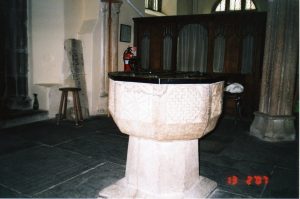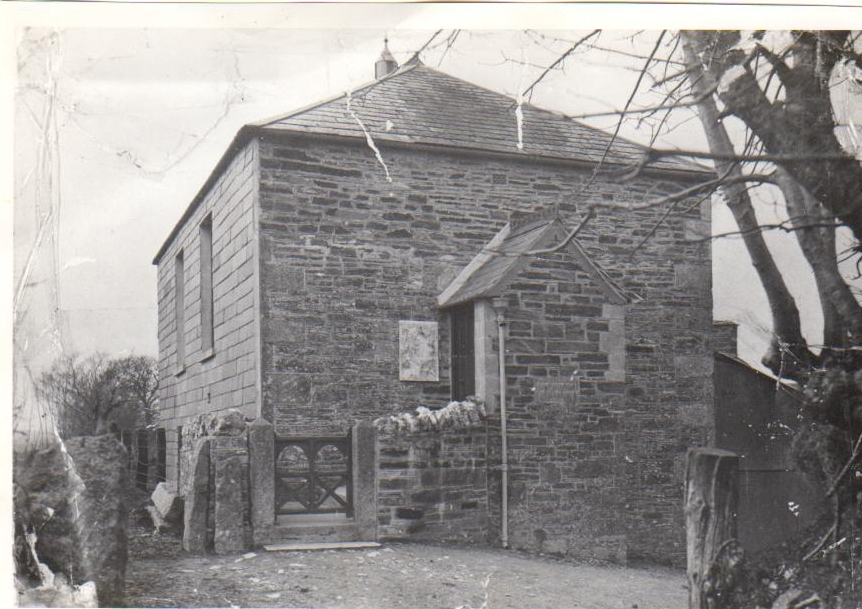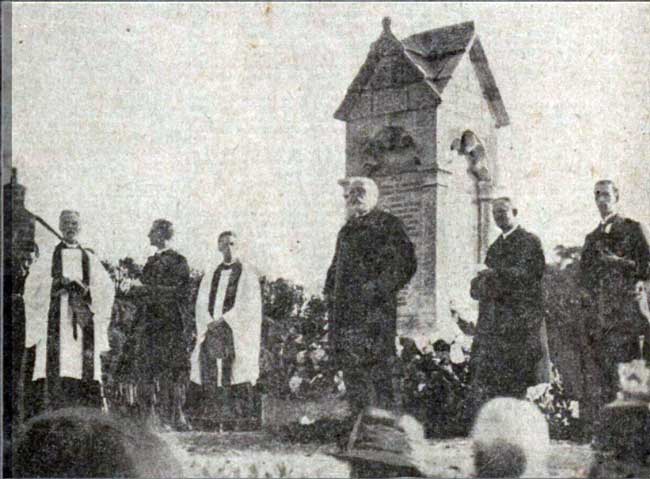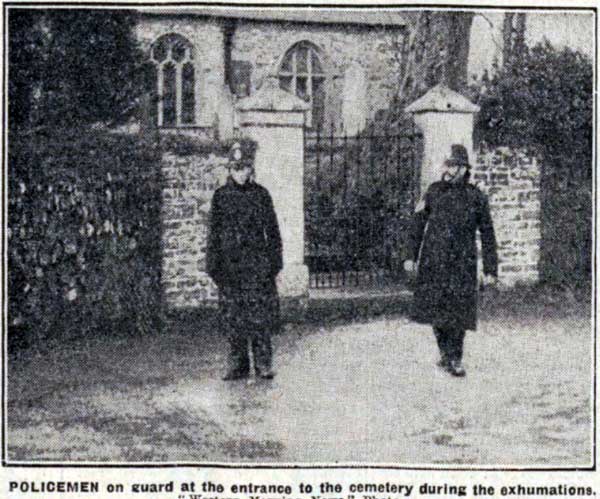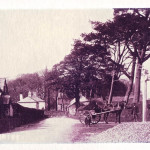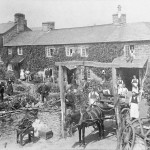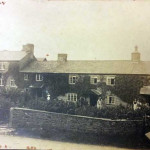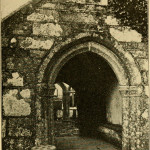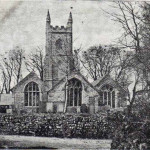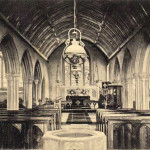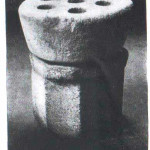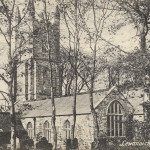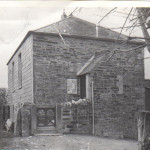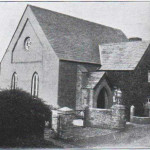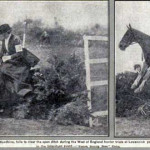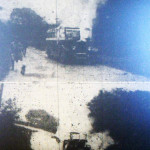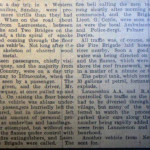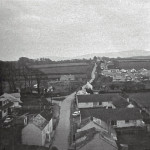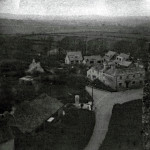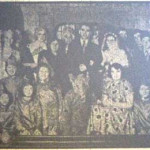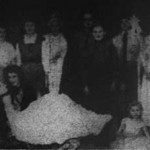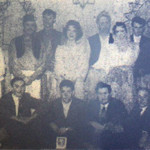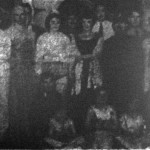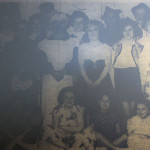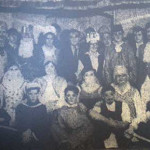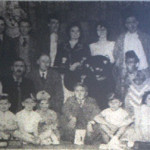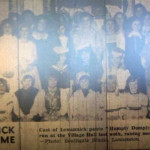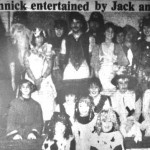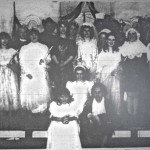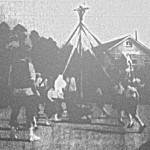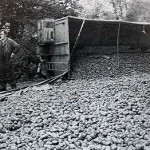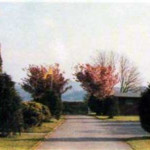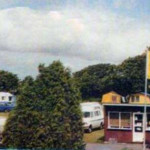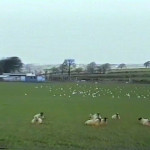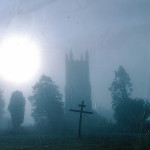.
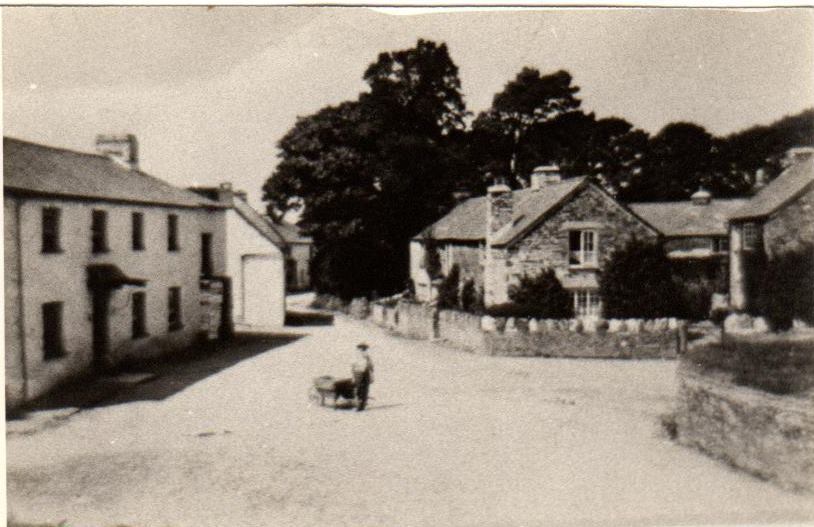
Lewannick (Lanwennock, Lannwenek, Lawaneck, Lewanecke, Lawannick) is situated approximately five miles southwest of Launceston. The civil parish has a population of 884, increasing to 973 at the 2011 census. The parish is within the Deanery and Hundred of East. It is bounded on the north by Trewen and South Petherwin, on the east by Lezant, on the south by North Hill and on the west by Altarnun. The parish church is dedicated to St Martin.
Evidence of early medieval habitation at Lewannick is in the form of two inscribed pillar stones, each having text in both Latin and ogham characters; on the basis of the ogham text, these stones have been dated as having been inscribed between the fifth and sixth centuries. One is located in the village churchyard, and was dedicated to a “Ingenuus”; the other has been moved inside to the church nave, and both texts mention an “Ulcagnus”. The Domesday Book, completed in 1086, mentions settlements within the Parish at Trelaske, Trewanta, Trevell and Polyphant (the Polefans and Polofant of the Domeday Book. Was held by Uluric in the Confessor’s days).
The principal villages in this parish, besides the church town, are Hicks Mill (Hix-Mill), Polyphant (Pollyfont), Plusha (Plashes Cross), Trenhorne, and Trevadlock. Hix-Mill can only be reckoned as partly in this parish; the only part which it can claim, lying on the west side of the bridge. On the eastern side the north part is in Trewen, and the southern in South Petherwin ; so that this small village lies in three parishes. At Polyphant there is a famous freestone quarry, which seems to have been well known to our Saxon ancestors, as the greater part of the semicircular arches with Saxon mouldings now to be found in the eastern part of Cornwall, appear to have been formed of this stone. The doorway at the White Hart Inn, in Launceston; the new house at Trebursey in South Petherwin ; and the Duke of Bedford’s house
in Milton Abbot parish in Devon, appear to be indebted to the stone of this almost inexhaustible quarry. On the barton of Trelaske there was formerly a manganese mine, from which a small quantity of this semi-metal was raised. It had a regular lode about ten fathoms from the surface ; but this was not a success and the mine was soon closed and abandoned. The little river Inney which falls into the Tamar at a place called Innysfoot, flows through the north and east of this parish, and the Lynher runs through it in the south and west.
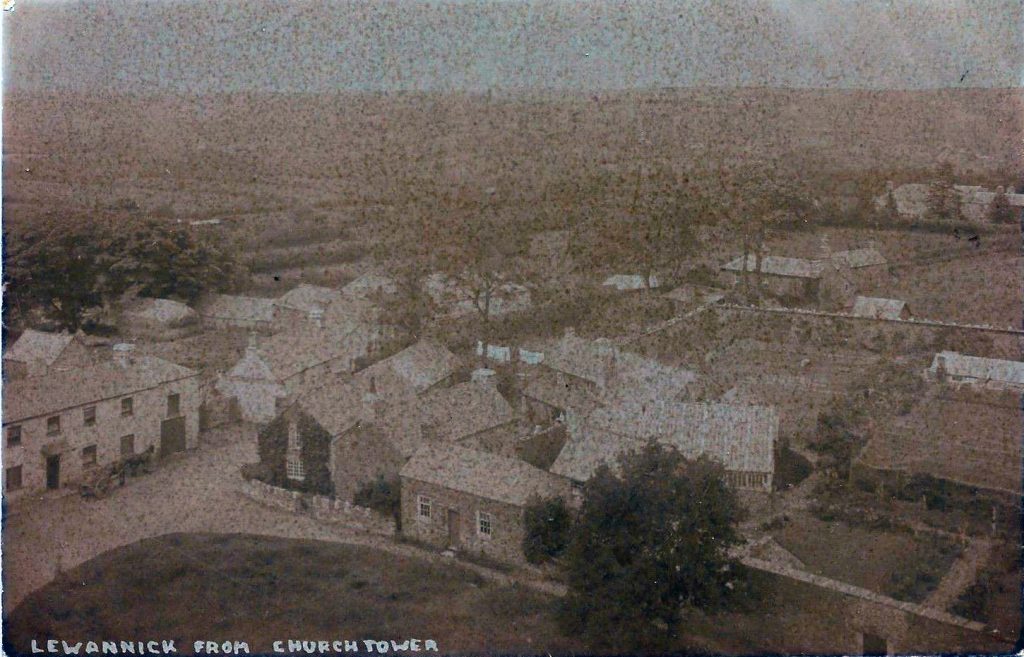
A new turnpike road was cut from Five Lanes, by Two Bridges, to Holloway-cross gate, avoiding the dangerous hills by Hicks’ s mill in the 1840’s. The flood on the 8th July,1847, swept away part of Two Bridges, and interrupted the communication later that year, when a new bridge was finished.
The manor of Trelaske belonged to the Upton family prior to the Reformation; but in the reign of Henry VIII. it was carried by co-heiresses to two brothers of the Lower family. Thomas Lower, Esq. who died in 1703, sold his moiety of the manor and the barton connected with it, to John Addis, Esq. whose son in 1720 purchased the other moiety of William Plowden and some others, into whose hands it had fallen. In 1741 William Addis, Esq. bequeathed the whole of this property to Nicholas Swete Archer, great uncle of Samuel Archer, Esq.
The manor of Tinney Hall belonged in the latter part of the seventeenth century, to Mrs. Dorothy Beaumont, who bequeathed it to her nephew John Speccot, Esq. of Penheale, by whom it was devised to Thomas Long, Esq. Who died about the year 1730, when it became the subject of expensive litigation. The decision was finally in favour of the Rev. Charles Sweet, of Kentisbury in Devonshire, who married Mr. L0ng’s daughter.
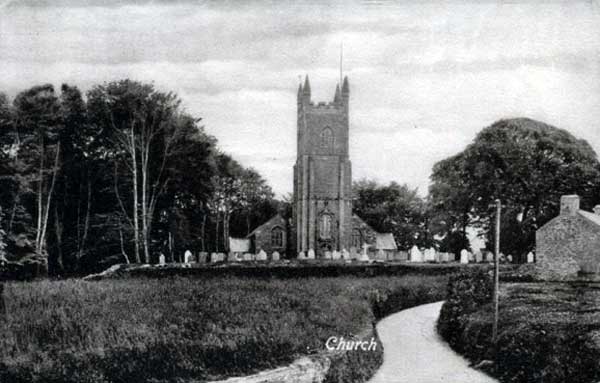
The Church is a building of local freestone in the Perpendicular style, consisting of chancel, nave of five bays, aisles, north and south porches and an embattled western tower of pinnacles containing 6 bells, cast in 1767 and recast after the 1890 fire which destroyed the Church. The fire took hold on the 11th of Janaury and was caused by a defective stove pipe. The stove had been lit at mid-day on the Saturday by the sexton, James Barber, for the purpose of warming the building for the usual Sunday service. Mrs. Wild, who lived opposite the Church, awoke at one o’clock on the Sunday morning to see the Church alight and immediatley raised the alarm, first arousing Isaac Dawe, coachman in the employ of the vicar (the Rev. C. H. Archer) and his two sons. The vicar and churchwardens (Messrs. R. Lukey and Reed) and the whole village were soon arounsed, and effort were at once made with the limited means at their disposal, to quell the flames with no avail. Issac Dawe made haste for Launceston where he summoned the Launceston volunteer fire brigade at 2:15 a.m. and with Lieut. Hayman in command were soon on the scene. By now the fire had already destroyed much of the building although the belfry was still intact. The brigade were soon hampered by the lack of a good supply of water and the fire gradually spread to the belfry, catching the ropes, and reaching the first of the three floors of the tower. The whole of the interior of the tower was soon ablaze and the bells fell to the floor. Although the monuments on the north side were not so damaged, those on the south, owing to the wind direction, were completely destroyed. The four carved and moulded freestone columns on the south side of the Church, dating back to 1540, were damaged beyond repair.
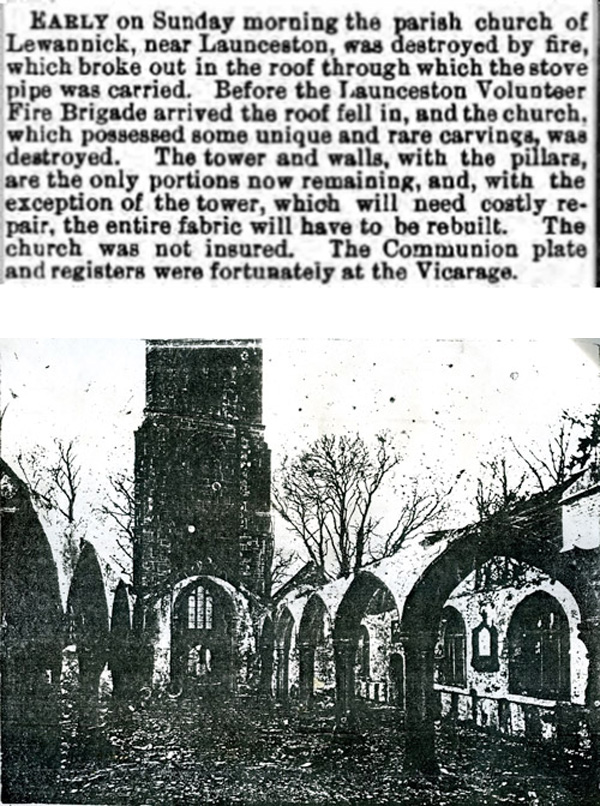
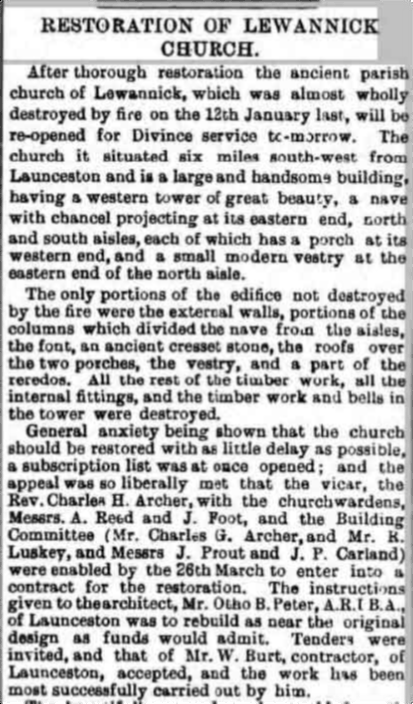
After the fire, the Church was rebuilt on the same plan as the former edifice, at a cost of nearly £2,000, under the direction of Launceston architect Otho Peter. A monument to Ezekiel Arscott, ob. 1682, with numerous memorials of later date to the families of Archer, Cundy and others, were all destroyed by the fire, together with the bench ends, many of which were of ancient carved oak. The chancel retains an ancient piscina and aumbry and there are 180 sittings. The register of baptisms dates from the year 1660; marraiges, 1775; burials, 1738, all which are available from the Truro Records Office.
Before the fire the Church was mainly seated with very ancient oak benches; on the end of one nearest to the south porch was the date 1546. They were richly carved throughout, somewhat similar to those of Altarnun Church, which were done about the same time. On one or two of the bench ends, in the north aisle, was the monogram A. U., i.e., Arthur Upton, of Upton, in this parish.
The bell, which were also greatly damaged by the fire, were re-cast by Mears and Stainbank, in 1890. The original bells were cast by the Penningtons, in 1767, who were noted bell-founders from Lezant. Each bell had an inscription as follows:-
1- “I call all ye to follow me. Penningtons, Makers, 1767.”
2- “God preserve the Church. I.P., F.A.P., (Fitz Anthony Pennington) 1767.”
3- “God save the King. I.P., F.A.P., 1767.”
4- “Penningtons cast us all. 1767.”
5- “Charles Bedford, Vicar. D. Cundy, junr., T. Bant, C.W., I.P., F.A.P., 1767.”
6- “I call the quick to Church, & Dead to Grave. Swete-Nicholas Archer, Esqr., 1767.”
In the Churchwarden’s accounts of Lewannick for 1767, are the following entries :-
“Mr. Pennington, towards running the New Bells, £30 0s. 0d.”
“Mr. Pennington, more for addition of Bell Metal, 6cwt. 25 lbs. at Six pounds per hundred, £45 17s. 0d.”
Before the fire the arms of Upton and Tresithney, were displayed in the east window of the north aisle. On the exterior of the east end of the same aisle were the arms of Trecarrel carved in granite. He is supposed to have been a generous benefactor to the Church. There is also standing on a low detached column a circular block of wrought granite, perforated with with seven holes, said to have been used for holding the seven symbolical candles and dates from the middle ages (Cresset Stone blow).

Monuments
Amongst the monuments and inscriptions that were destroyed in the 1890 fire was this one to Ezekiel Arscott :-
“Rise enobled Cerean, & religious gent, by birth, by life, by death.
Semel calcanda vis lethi.
here lies interred a saint that lived to dy;
and being dead yet lives eternally,
what though ezechiel here under ly,
yet arscot’s soal is soard above ye sky.
what though strong death made his weak body yeeld
yet israel’s strength caused him to win ye feeld
he always led his life as on prepar’d to dy;
hees dead yet lives to shine perpetually.
Buried on the 3rd day of July, An’o Dom. 1682.”
There were also several monuments and tablets to the Archer family, inscribed :-
“MEMORLE SACRUM
In the vault adjoining the north wall of this Church are deposited the Remains of Edward Archer, Esqr., of Trelaske in this parish, Obiit 11th November, 1802;AET.60.
Theophila, wife of Edward Archer, Obt. 30th April, 1798; AET. 42. Dorothy Ayre, wife of Samuel Archer, Esqr., Obt. 7th May, 1797; AET.39
Jane Archer, daughter of Samuel Archer, Esqr., Obt., 12th June, 1818; AET. 28.
Samuel Archer, Esq. of Trelaske in this Parish, Obt. 6th June, 1822; AET. 77.”
“Adjoining the north wall of this Church are deposited the remains of the Revd. Samuel Archer, vicar of this parish; Obiit January 9th, 1831; AET. 36. Edward Archer, Esq., of Trelaske in this parish; Obiit May 16th 1834; AET. 42. William his son; Obiit March 23rd, 1832; AET. 19 months.”
“Sacred to the memory of Jane, the beloved wife of the Revd. Charles H. Archer, and daughter of William Rashleigh, of Menabilly, Esqr.; who died at Menabilly, Oct. 23rd, 1854; in the 31st year of her age. Her remains are interred in the family vault of her ancestors at Tywardrath.”
“In memory of William Vosper, Esqr., Barrister at law, who fell asleep in Jesus April 5th, 1855; aged 51. His end was peace.
Also Eliza widow of the above, and wife of the Revd. W. Tare, who was suddenly removed to her heavenly home, November 5th, 1867; aged 64. Wisely waiting for her Lord.”
In the Churchyard are monuments which bear the following inscriptions :-
“Here lyeth the body of Richard Wadge of this parish, yeoman, who was buried the fifth day of June, in ye year of our Lord 1740, and in the 78th year of his age.
Here lyes the dear remains of one,
Who loved all, and injured none,
So honest pious and so kind
He’s left but few such here behind,
He served three masters with all care;
In Sundays only full eight year,
And now he’s gone entom’d in dust
To rise in glory with the just.
Johannes Wells, Sculp, 1740.”
In memory of one Richard Spear and his two sons there is the following epitaph:-
“Almighty God with age hath brought me here
To lodge in grave with my 2 children dear,
The father and 2 sons entom’d do lie
Who feared God and lived in unity
The Yound Men’s life was short like to a span
Their father lived in years near 81
Their good fame the actions of the just
From youth to age shall blossom in the dust.”
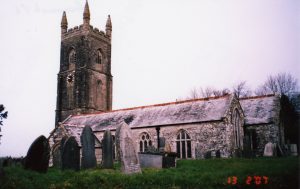
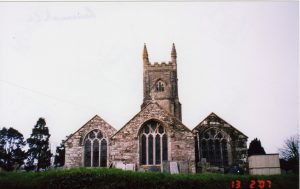
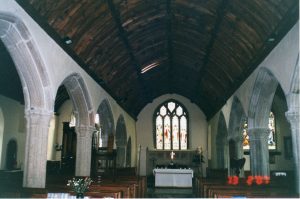
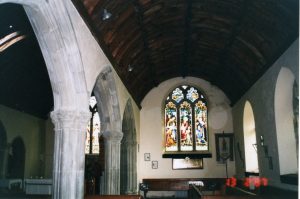
Methodism
It was not until 1810 that the Chapel at Trevadlock Cross (above in 1900 formerly known as Varley Cross Chapel) was built, but the first Methodist Prayer Meetings were held in the house of a shoemaker, named Evans, in 1805. These were conducted by one of the earliest to introduce Methodism into Lewannick ‘Uncle Will Downing,’ and Mr. William Dingley, of Knighton (anciently Netherton). They faced a very hostile reception from George Mangles the clergyman of the parish at the time, who threatened to withdraw his custom from the shoemaker if he continued to harbour the Methodists. With this threat. Mr. Evans withdrew his consent for the Methodists to meet at his property. Undaunted, the Methodists hired a room, in Lewannick village near the church gate, of a widow named Peter, for £4 per annum. The clergyman again interfered, and offered the owner of the property £14 a year which was duly accepted, and both the widow and Methodists were turned out of the house. Again the Methodists were not put off, and in 1807 they rented a cottage from local farmer Reginald Jenkin who himself rented the property from another person. The cottage was fitted up for a place of worship. In doing this, the tenant permitted alterations that were not allowedable by law. The Reverend Mangles again took matters into his own hands by employing a Plymouth lawyer, and Jenkin was told that he would be prosecuted unless he gave forty shillings worth of bread to the poor, and turn out the Wesleyan’s from the cottage. This he did, saying at the time “I do not like law, and the bread would do good to the poor.” By this time, the Wesleyan’s had formed a class lead by a Mr. Jasper and the meetings were preceded by a preaching service. Mr. Webb of Wisewandra, was the first preacher. Driven yet again from a place with which to meet, in 1808 the small group of persecuted Wesleyan’s were given the use of an unoccupied room, at the east end of their dwelling at Trevadlock by John and Grace Nanscawen Dawe. The room was prepared and adapted as a place of religious worship. With John Dawe being a yeoman, and the house his own, neither the Reverend or law could molest the group, but this still did not deter George Mangles and in a vindictive spirit resolved to bring ruin upon Mr. Dawe and his family. He said, “If it had not been for Dawe, at Trevadlock, I should have driven the Methodists out of the parish. I’ll ruin hime, however; I’ll break composition for Tithes, and take them in kind.” The following notice was therefore served :-
“Mr. Jno. Nanscawen Dawe,
I hereby give you notice to set out and account to me from the first day of March next ensuing for your Vicarial Tithes in kind of all the Lands and premises which you do now, or shall then occupy, or farm in the parish of Lewannick, in the County of Cornwall, as all Composition for such Tithes will be determined and expired on that day. And I hereby inform you that I appoint the place for your giving notice of setting out such Tithes to be at the Vicarage House at Lewannick aforesaid, there to be delivered or left with or for me, or for my agent, whom I shall for that purpose nominate.
Witness my hand this 30th day of August, 1810. Geo, Mangles, Vicar. Witnessed by Geo. Smith.”
George Mangles knew full well that John Dawe could do nothing but to comply with the rigid Tithe, but as he prepared accordingly with the request, fate took a hand and the Revered George Mangles suddenly died, this rendering the notice void. Duly relieved, John Dawe, offered the Wesleyan’s a piece of land at Trevadlock Cross for a Chapel and £10 as a donation.
During the construction of the Chapel, the Reverend William Beal conducted an open-air service on the site, and a man on the opposing side of the road, who owned that land, standing on the hedge, uttered imprecations and exclamations, saying “Now you are going to build a conventicle so near my property, I shall not be able to keep either duck or fowl.” The Chapel was opened for worship on Good Friday, 1811. Methodism had taken root and in 1836 a Chapel Keepers cottage was built. The congregation continued to grow and ‘Varley Cross’ Chapel, as it was commonly called, was enlarged in size in 1849 this was after the burial ground was provided in 1844. In 1886, the Chapel was re-seated, the School-room enlarged and new vestries built. and in 1899 the Chapel was completely renovated and was re-opened on September the 28th, as a jubilee celebration of the former enlargement.
Such was the success of the Wesleyan’s, that in 1887 a new Chapel was built at Polyphant, with a burial ground.
In 1901, James Venning penned this poem reminiscing of his school days at Trevadlock Chapel:-
REMINISCENCES OF MY SCHOOL DAYS.
“Twas at the old school of Trevadlock Cross,
Some lessons I learnt of ‘Profit and Loss;’
Here by the roadside I often used to play,
And spent many happy hours of childhood day.
No wonder one feels to revere the spot,
And think oft of old scenes not soon forgot;
Of the many friends and familiar faces
That once gathered here from various places.
But of! What has become of them since?
Some have grown to either women or men;
Whilst others alas! their dust and ashes lie
In the silent ‘Gods Acre’ that’s so near by.
Many more have gone to a foreign soil,
But others have been left at home to toil;
Some have sailed safe o’er the stormy sea of life,
Others have sunk in the surging waves of strife.
The Masters who taught us I can recall,
There’s Madrum, Frederick, and also Hall;
Only a few of the scholars I can mind,
Or where they reside now I cannot well find;
Amongst them were the Dawes, Peters and Dunn,
And in our childish games we had such fun;
The Wevills, and Turners, Kittow, Gryllas and Prout,
Such a host of others – their names are left out.
I think of those days with their mirthful glee,
To which the soul looks back -a glimpse to see;
For nigh forty years have glided past since then;
The days can never be quite the same again.
The past sheds an influence on life’s way;
Its memories are helpful for to-day,
And manhood’s experience of ‘Profit and Loss;’
Makes me prize the old School of Trevadlock Cross.
However, like so many other Chapels in the country, with a dwindling congregation, the Capel closed in the early 1990’s, with the congregation moving to use the more modern Chapel at Polyphant.
The Bible Christians also built a Chapel in Lewannick near Tinney Hall Farm (below). Tinney Hall, anciently ‘Kenny Hall,’ formerly belonged to the family of Beaumont. This Chapel is now a private residence.
Upton Castle
Two miles south-west, in the valley of the river Lynher, are the fragmentary remains of the medieval Upton Castle (below). Upton Castle occupies a slight E/W knoll in a valley hemmed in by much higher ground to the north, south and west.
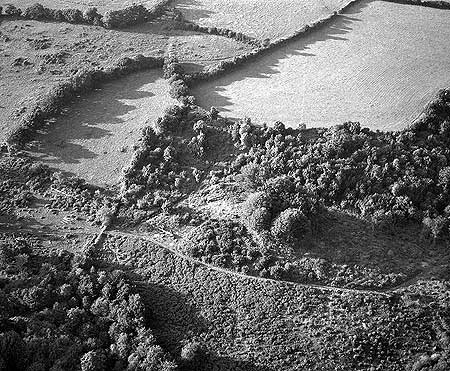
Immediately north of the Castle there is a natural gully, some 80m wide and 5m deep. To the south there is 100m of almost level ground with a 3m high ‘cliff’ bounding the River Lynher. Upton would seem to be a defended manor house rather than a true castle, hidden in a narrow valley, with little or no strategic value. It is believed that John Upton, mentioned in 1140 (his death), was of Upton Castle. It is probably of early medieval date though whether the defence was original or induced by the period of anarchy is open to question. The castle is now just a ruined courtyard, covered in moss.
The estate of Upton was passed down from the previous mentioned John Upton to his son Andrew who died in 1170. The estate then fell to his son Hamlyn, who married the daughter and heir of Sir Andrew Treloske, of Trelaske in the same parish. Hamlyn Upton died in 1218, and was succeeded at Upton by his son Edward, who died in 1284. He was succeeded by his son Richard, who left issue John Upton, who in the reign of Richard II., married Margaret Mules, and left a son Thomas who succeeded him. This Thomas Upton married Johanna, or Joan, daughter of the celebrated Sir John Trelawny, and left issue three sons and three daughters. Tow of the sons bore the name of John. The first John left one child, William, who died in 1478 leaving no issue, and left to his uncles, William Upton, senior, and John Upton, all his lands of Uppetoun, Trewynne, Hayes, Treswen, and Penventown, for ever. The second John, who was the thrid son, married in 1460, and died in 1489, and left issue. After various family descents the estate came to two daughters, co-heiresses, Margaret Upton and Jane Upton, who both intermarried with members of the Lower family of Polscoe, St. Winnow. One of these daughters had Trelaske as her marriage portion.
At what date the Upton’s parted with their ancient seat of Upton it is not known; but it is clear that one of the family, namely, John Upton, was in possession of the estate in 1613; the closes of land there alluded to as ‘the Teenets.’ being still known by that name. It was sold by Peter Wadge to the Rodd family of Trebartha, North Hill. Tenants during the 19th century had been the Vosper’s and three generations of the Venning family. In the early 20th century the farm was purchased by Henry Wadge and to this day remains in the ownership of his descendant’s.
Lewannick’s Fallen from the First World War
Lewannick war memorial dedication in November 1921 by Sir George Croydon- Marks MP.
Eric Augustine Bennetts

Eric was born on the 28th of August 1895 at St. Agnes to Thomas and Annie Bennetts. His Father was a Clergyman and was the Vicar of Lewannick (Where Eric spent most of his childhood) up to 1914 when the family moved to Cape Town, South Africa. He attended Hazeldon Preparatory School, Tavistock, Devon before going to Sherborne School (The Green) from September 1909 to July 1913, he was a scholar in the 6th form. He won the Digby Maths prize in1913. He completed his studies at a college in Cape Town. He originally was a Lance-Corporal in the Cape Town Highlanders, South African Defence Force (Signalling Instructor) but in the spring of 1916 he returned to England to join the Royal Flying Corp (R36035) and became a Flight Sub Lieutenant in the Royal Navy Air Service. He was reported missing in September 1917 after his plane, a Sopwith Camel F1 biplane, collided with another British Sopwith, piloted by Philip Johnston, behind enemy lines and was confirmed as having died in February 1918.He is interred at the Cabaret-Rouge British Cemetery, Souchez, epartement du Pas-de-Calais, Nord-Pas-de-Calais, France, Plot: XV. R. 22.
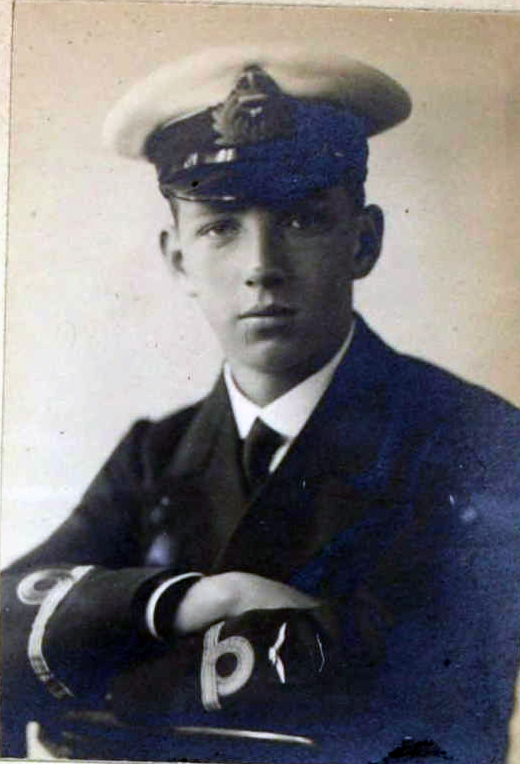
On the 26th of February 1918 a service of commemoration was held at Lewannick Church with the tributes being paid: Floral tribute – “In loving memory of dear Eric from Commander & Mrs Watts Russel. From all at Pen Tamar.”Floral tribute – “In proud & loving memory of Eric & those who fell in the Great War from this Parish. Mrs & Miss Bennetts of Lifton.“Floral tribute – “In proud & loving memory of Eric Augustine Bennetts & all those who from this Parish fell in the Great War, from Rev. & Mrs W.T. Bennetts.”
At the time of his death, his Sister, Evelyn Maud Bennetts, was living at Roydon Road, Launceston, the address he used as a place of residence. For this reason he is mentioned on the St. Stephens Church roll of honour as well as being commemorated on the Lewannick War Memorial.
William Frederick Bettess
William was born in 1889 to Cecilia Bettess at Trewen. In 1911 he is living with his mother and stepfather Joseph Congdon at Polyphant and working as a Stonemason. On the 22nd of April 1912 he married Emma J Maunder at Lewannick and they set up home at Bovey Tracey, Devon. Working then as a Gardener. He enlisted at Newton Abbot with the Devonshire Regiment (Regimental No. 315012) as a Lance Corporal but was later transferred to the Wiltshire Regiment (Duke of Edinburgh’s) (Regimental No. 203106) serving with the 2nd Battalion as part of the 30th Division. In three years of action on the Western Front, the 2nd Wilts took part in most of the major engagements, including the battles of Neuve Chapelle, Aubers, Loos, Albert, Arras and Third Ypres. It was during the Third Battle of Ypres or as it is better known, Battle of Passchendaele, that William was killed in action on October 27th, 1917. His death would have occurred during the Second Battle of Passchendaele where the battle took place in the Ypres Salient, in and around the Belgian village of Passchendaele, between 26 October and 10 November 1917. This was a continuation of the advance started with the First Battle of Passchendaele and ultimately led to the capturing of the village. William was interred at the Torreken Farm Cemetery, Belgium Plot 1, Row E, Grave 16. His wife had moved to Bathpool by the time of his death. Emma later remarried to William Sandercock in 1941.
John Thomas Brown (with thanks to Ken Ripper of the North Hill Local History Group)
John was born in 1871 at 52 Adelaide Street, Portsea, Hampshire; to John and Susannah (nee Wakem) Brown. His father was a Labourer and Local Methodist Preacher. In 1875 John’s father remarried to Martha Wakem; Martha was the sister of Susanna who died in 1870. John trained as a Carpenter & Wheelwright, and in 1891 was working for Fred Truscott at Five Lanes. On September 28th, 1891, He attested to join the Duke of Cornwall’s Light Infantry at Bodmin for 12 years; age 20 years 10 moths; a carpenter; service number C/3495; single; 5’ 6.75” – 127½ lbs – fresh complexion – dark brown hair – scars on right thumb and left wrist. At the time his father was listed as living at Polyphant. (His full military record). He was promoted to Pioneer Sergeant in May 1898. On September 20th, 1902 he re-engaged to Royal Warwickshire Regiment at Malta to complete 21 years service. He was finally discharged on January 13th, 1913, on the termination of his second period of engagement as a Pioneer Sergeant having served 21 years 105 days.
He passed a medical examination in Exeter on September 7th, 1913, and enlisted with the 8th Battalion of the Devon Regiment as a Sergeant (Regimental No. 37282). Seeing action in France from April 1915, John was with his Battalion at Pont Nieppe, Nord, France (The bridge at Pont-de-Nieppe was seized by the 1st Hampshire Regiment on 16 October 1914 and the village then stayed within the Allied lines until 11 April 1918), when he was ordered to hospital after reporting an unusual heart beat in his chest. In November he was transferred to hospital at Balleiul and then CCS and then Boulogne; from here he was sent to Marlborough Rest Camp where he was assessed by a medical board that decided he should be sent to Queen Mary’s Military Hospital, Whalley, Lancashire. He was admitted to Queen Mary’s Military Hospital on November 2th, 1916 suffering from Ventricular Disease of the Heart staying here for 28 days before he was discharged on December 19th, 1916. He was then officially discharged on January 4th, 1917, due to heart disease.
Discharged; unfit for service; stamped TOTAL DISABLEMENT
Cause of discharge: Physically unfit VDH aortic
“Originated October 31st 1916 at Pont Nieppe. Did not enjoy his food. Two mornings after he could hear musical sounds distinctly in his chest with violent throbbings. Could not account for the condition beyond very hard work. I fairly good condition muscularly but unfitted for further military service on account of his heart disease. Distinct diastolic murmur of aortic valves, propagated down to sternum. Heart slightly enlarged on the left. There is no organic deisease of the heart. Compensation is adequate for a sedentary life. The result of active service.
He returned to Cornwall to live with his wife Jane and step-daughter Beatrice at Hillside Cottage, Hicks Mill, Lewannick and worked as a woodman. He passed away on August 26th, 1919, at home. Floral tributes -“In loving memory of dear cousin J. T. Brown from Ellen.“”In loving memory of Dad from Beatie.“”In loving memory of John Thomas Brown, 8th Devon Regt, from his loving wife Jane Brown.“
Ernest E Cox
Ernest was born in 1895 at Kings Cross, London to Henry and Emily Cox. He came to Cornwall after leaving school and in 1911 he was working for Mr. James Daniel at Trelaske Barton, Lewannick as a ‘Boy of all Work’. He was a regular with the United Methodist Church. He was one of the first to volunteer at the first recruiting meeting held in the schoolroom at Lewannick, enlisting with the Duke of Cornwall’s Light Infantry as a Private (Regimental No. 200809) serving with the 1st/4th Battalion. Ernest served initially in India arriving in November 1914. The Battalion was then transferred to Aden on January 22nd, 1916 and here they stayed until they were posted to Egypt arriving at Suez in February 1917. Here the Battalion was transferred to first the 232nd Brigade then the 233rd Brigade before finally becoming part of the 234th Brigade of the 75th Division and engaging in various actions as part of the Palestine Campaign including in 1917; The Third Battle of Gaza, The Capture of Gaza, The Capture of Junction Station, The Battle of Nebi Samweil. The Battle of Nebi Samwil, (November 17th-24th, 1917), was fought during the decisive British Empire victory at the Battle of Jerusalem between the forces of the Egyptian Expeditionary Force and the Ottoman Empire’s Yildirim Army Group during the Sinai and Palestine Campaign, in the First World War. The Battle of Jerusalem began two days after the end of the decisive EEF victory at the Battle of Mughar Ridge which occurred after the EEF defeated the Ottoman Army at the decisive victory at the Battle of Beersheba and Third Battle of Gaza.
The battle was the first attempt by the forces of the British Empire to capture Jerusalem. The village of Nebi Samwil (now spelled Nabi Samwil), also known as the “Tomb of Samuel“, was part of the Ottoman defences in front of Jerusalem and its capture was considered vital to the eventual capture of the city. The British attacking force consisted of three divisions, two infantry and one mounted.
The village was captured by the 234th Brigade, part of the 75th Division, on November 21st, 1917. However they still had to defend it against Ottoman counter-attacks almost every day. Unsupported by their heavy weapons the British infantry could not break through the main Ottoman defensive line and the attack failed to reach its objective Jerusalem. It was during this battle that Ernest was killed in action on the Thursday of November 22nd, 1917. He was interred at the Jerusalem war cemetery, Plot G, Grave 45. He is commemorated on the Lewannick War Memorial. He had been engaged to be married.
Alfred Henry Dawe (with special thanks to Downing College, Cambridge)
Alfred was born in 1895 to Joseph and Emily (nee Percy) Dawe at Trevadlock, Lewannick. His father was a farmer in Trevadlock. By 1901 the family are living in Wyddial Bury, Wyddial, Royston, Hertfordshire. Alfred was educated at the East Anglian School in Bury St. Edmunds, and from there he went to the Leys School in Cambridge in January 1911. At The Leys, where he was in West House, he was very well regarded and stayed for two years, leaving as a sub-prefect. On leaving Leys school Alfred went to University at Cambridge to study science. He matriculated at Downing College in 1913 with the intention of reading for the Natural Sciences Tripos and the Diploma in Agriculture. Following the outbreak of war, he joined the University’s Officer Training Corps in October 1914, at the start of his second year. At the end of that month he took part in the College Debating Society’s Freshmen’s debate. In early November 1914, with student numbers in College and Cambridge dropping as members left on military service, he played in a joint Downing-Queens’ rugby team against a team made up of Welsh Internationals and Cambridge Blues, afterwards described as a ‘sound hard-working forward’. By the end of Michaelmas Term 1914, Dawe had obtained his commission in the King’s Royal Rifle Corps as Temporary 2nd Lieutenant serving with the 13th Battalion. A serious motor cycle accident delayed his going abroad with his regiment until February 1916, when he rejoined them in France. His enlistment form shows Alfred to be of 5 feet 11.5 inches tall (181.6 cm), weighed 154 lbs (70.1 kg) chest 33″ to 36.5″ (83.8 to 92.7 cm). Along with his Battalion, Alfred took part in the many Battles Of The Somme in 1916 such as the Battles of Albert, Bazentin Ridge, Pozieres Ridge and finally in November 1916 the Battle Of The Ancre. On the April 11th, 1917, having already fought in the First Battle Of The Scarpe during the Battle Of Arras he was leading his company as acting Captain and, with another company, succeeded in taking the strongly fortified village of Monchy-Le-Preux. He then went forward to select a suitable spot on which to consolidate their position when he was killed instantaneously. He was serving with the 13th Battalion at the time. His body was never identified but his name is commemorated on the Arras Memorial Bay 7, Coarse B, Stone 14. He was the nephew of Elizabeth and Jane Dawe of Trevadlock who gave the land for the War Memorial in Lewannick on which Alfred is commemorated. He is also commemorated online at Culford Remembers and at Downing College
Harry Down
Harry was born in 1898 at St. Issey to George and Elizabeth Down. His father was a Horseman working for Mr. George Venning at Upton Barton in 1901 but by 1911 they had moved to Tinney Hall where George worked as a Farm Labourer. The family were United Methodists. He enlisted as a Private at Launceston on June 7th, 1916 initially with the Devonshire Yeomanry (Regimental No. 220287) 3rd/1st Battalion. In the summer the Battalion was affiliated to a Reserve Cavalry Regiment at Tidworth Camp. In the summer of 1916 it was dismounted and attached to the 3rd Line Groups of the Wessex Division as its 1st Line was serving as infantry. It was then disbanded in early 1917 with personnel transferring to the 2nd Line regiment or to the 4th (Reserve) Battalion of the Devonshire Regiment at Bournemouth. Harry was transferred to the Cheshire Regiment (Regimental No. 72165) on April 12th, 1918. Serving with the 9th Battalion of the 56th Brigade of the 19th (Western) Division in France. On May 27th the Germans launched their attack in Champagne starting the Third Battle of the Aisne. The Third Battle of the Aisne was a battle of the German Spring Offensive that focused on capturing the Chemin des Dames Ridge before the American Expeditionary Forces arrived completely in France. It was one of a series of offensives, known as the Kaiserschlacht, launched by the Germans in the spring and summer of 1918. Over the night of May 28th and 29th, the Battalion was rushed by bus towards the front line. During the 30th, it marched towards a reserve position where it was held in readiness to cover a withdrawal of other units. The expected attack came about 1pm and the troops retired, now leaving the Cheshires in the front line, on high ground north west of the village of Sarcy, some 25 kilometres south west of Reims. During the evening, they were also able to retire to a position to the south of the village. The Regimental History records “Attack was certain, but it was most difficult to select, organise and dig a defensive position owing to the standing corn. About midday, German artillery and machine guns opened on the Battalion. They had excellent observation of our positions from the high ground immediately south of Sarcy and west of the Sarcy-Chambrecy road…….Their fire grew in intensity until mid-afternoon, when the left of our front in the valley was a perfect inferno of high explosive and machine gun fire, against which our hastily improvised cover was useless. Most of the officers were killed or wounded.” At 3.15pm, the position became untenable and Colonel Cunninghame withdrew the remnants of his Battalion so they could be re-organised. Once this was done, he led them forward again to capture the German positions on the high ground west of the road. There had been so many casualties, including 42 dead, that the Battalion had insufficient strength to hold the section of the front line allotted to it. It was forced to retreat to nearby positions on the Mont be Bligny. The next few days were characterised by small scale warfare with the Germans continually harassing the British front line with artillery fire and raids. During all this Harry was reported as missing on the May 31st, 1918. On the September 9th it was confirmed that he had been in all probability killed in action or died of wounds on or soon after May 31st, 1918 by Major Hodrington. He was interred at the Chambrecy British Cemetery, Morne, France. Grave Plot 1, Row E, Grave 7. He is commemorated on the Lewannick War Memorial. Floral tribute – “In loving memory of dear Harry from his loving Father,Mother, brother & sisters.”
Charles Wilfred Eales
Charles was born in 1893 to the Rev. Henry William Eales and his wife at Durham. His father was the Vicar of Lewannick. He attended Weymouth College before taking up an apprenticeship in Electrical Engineering. He enlisted with the Royal Engineers before transferring to the Devonshire Regiment serving with the 2nd Battalion as a Lieutenant rising to 2nd Lieutenant. The 2nd Battalion, assigned to the 23rd Brigade, 8th Division, was another Regular Army unit, that was awarded the French Croix de guerre for holding up the massive final German advance of the war at the Bois des Buttes on May 27th, 1918, the first day of the Third Battle of the Aisne. General Henri Berthelot, General Office Commanding the French 5th Army in his Order of the Day of August 20th, 1918 said: “Thus the whole battalion, colonel, 28 officers and 552 non-commissioned officers and men, responded with one accord and offered their lives in ungrudging sacrifice to the sacred cause of the Allies.” Charles was killed in action near Cambrai as his unit were attempting to break the Hindenburg Line near the Canal du Nord on the 27th of September 1918. His body was never identified but his name is commemorated upon the Vis-en-Artois Memoiral, Pas de Calais, France, Panel 4. He is commemorated on the Lewannick War Memorial.
Frank Jasper
Frank born at Lezant, enlisted with the 1st Battalion of the Worcestershire Regiment (Regimental No. 36436) as a Private. He was killed during the Action at Bouchavesnes on March 4th, 1917. As dawn broke (5.30 a.m.) on March 4th the British artillery opened a barrage fire. The opening crash of the bombardment served as signal (This was a variant on the usual method of synchronised watches) to the battalions detailed for the attack, and all along the front of the British trenches troops swarmed out and poured forward in a series of waves. The 1st Worcestershire were in the centre of the attacking line, with the 2nd Northamptonshire on the left. The right flank of the Worcestershire was on the road from Bouchavesnes to Moislains; south of the road the 2nd Royal Berkshire continued the front of attack. The attack was immediately successful. The German front line,”Pallas Trench,” was easily overrun and the attackers swept onward to their further objective, “Fritz Trench,” the German second line. Led by Captain N. H. Stone, Lieutenant R. A. O’Donovan and 2/Lieut. J. A. Smithin the Worcestershire platoons charged “Fritz Trench.” These three officers were awarded the M.C. There was a short but desperate struggle. The enemy resisted to the last, but the attackers were not to be denied. For a few minutes a German machine-gun held up the onslaught, but the gun was rushed and captured by a party headed by Sergeant T. Guest. Sergeant Guest was awarded the D.C.M. for his actions. Within a quarter of an hour from the start “Fritz Trench” had been secured. Frank’s body was never identified but his name is commemorated on the Thiepval Memorial, Somme, France Pier and Face 5 A and 6 c. He is commemorated on the Lewannick War Memorial.
Thomas Kent
Thomas was born in 1888 to John Wills and Mary Jane Kent at Higher Trevell, Lewannick. His father was a Agricultural Labourer. Thomas enlisted with the Duke of Cornwall’s Light Infantry as a Private (Regimental No. 240906) serving with the 2nd/5th Battalion. He died on Saturday November 17th, 1917 and is buried at Trevadlock Cross Wesleyan Chapelyard. Interred Floral tribute – “In ever loving memory of dear Tommy , from Father,Mother, Will and Annie. ” He is commemorated on the Lewannick War Memorial.
Maurice Blandford Lock
Maurice was born in 1894 to James and Emma Lock at Milverton, Somerset. His father was a Domestic Coachman working for Hannah Wrangham of Bowden Derra, Polyphant. He enlisted as a Private in March 1915 with the Duke of Cornwall’s Light Infantry but was attached to the Hampshire Regiment when he embarked with his unit in December 1915 for Mesopotania. He was in the thick of the fighting there but succumbed to fever in Basra, Mesopotania, in 1916 aged 23. He is commemorated on the Lewannick War Memorial.
Samuel John Marks
Samuel was born in 1897 to John and Mary Marks at St.Stephens, Launceston. His Father was a Wood Ranger (Woodman). They moved to Hurdon Down in 1901 where the family settled. By 1911 Samuel was joined by 4 Brothers and 1 Sister.
He enlisted with Devonshire’s at first (3rd Devon Bte 4th Wessex Bde) at Tavistock in 1914 but had transferred to the Royal Field Artillery by 1916 as a Driver (Regimental No 1300). He was injured during an accident and died of his wounds on the 24th August 1916 at Salonika, Greece. And was interred at the Mirka British Cemetery, Kalamaria, Grave ref 1666. He is commemorated on the Lewannick War Memorial and Launceston War Memorial.
Operated by the Royal Field Artillery, the Divisional Ammunition Column was responsible for transporting all the ammunition, both artillery and small arms, for the Division. The Divisional Ammunition Column collected ammunition from the Army Service Corps Divisional Ammunition Park for onward transportation to a re-filling point where it could be transferred to a Brigade Ammunition Column. When during 1916 Brigade Ammunition Columns were dispensed with the Divisional Ammunition Column became responsible for transporting the ammunition to a re-filling point where it could be collected by ammunition wagons belonging to the individual batteries. At any one time, a Divisional Ammunition Column, together with the tactical units of the Division held one scale (the designated allocation of ammunition for the division). A second scale of ammunition was stored in the Divisional Ammunition Park whilst a third scale was stored in the Ordnance Depot. A Divisional Ammunition Column comprised 4 Sections, namely, No’s 1, 2 and 3 Sections which handled 18-pounder and small-arms ammunition, and No 4 Section which had a “Howitzer portion” for 4.5-inch and a “Heavy Portion” for 60-pounder ammunition. The latter portion was removed from the establishment in early in 1915 when the 60-pdr guns were withdrawn from divisions.
With knowledge that Romania was about to join the Allied side, General Sarrail began preparations for an attack on the Bulgarian armies facing his forces. The Germans made plans of their own for a “spoiling attack”. The German offensive was launched on August 17th, just three days before the French offensive was scheduled to start. In reality, this was a Bulgarian offensive, as the Austro-Hungarian Army was in Albania and only one German division was on the Greek border. The Bulgarians attacked on two fronts. In the east, they easily conquered all Greek territory east of the river Struma (see Struma Offensive), since the Greek Army was ordered not to resist by the pro-German King Constantine. In the west, where Samuel was positioned, the attack achieved early success thanks to surprise but the Allied forces held a defensive line after two weeks. Having halted the Bulgarian offensive, the Allies staged a counter-attack starting on September 12th (Battle of Kaymakchalan)
John Martyn
John was born in 1891 at Lewannick to William and Annie Martyn. His father was the Postmaster and Groucer for the village. Educated at Lewannick and Shebbear College, he then worked for four years in Weston-Super-Mare with Messrs T. Salisbury and Sons . He then went to London and worked in the warehouse of Messrs Cook, Son and Co. St. Paul’s Churchyard. He volunteered in Aug 1914 but was rejected because of dental problems. In November 1914 he was accepted for foreign service with the London Regiment (Regimental No. 820419) (The Queens Westminsters) serving with the 1st and 6th Battalions after 18 months training and duty on East coast but was then rejected because of varicose veins . Had had an operation in Colchester Military Hospital and then left for foreign service with the 16th Battalion on May 19th, 1917. There is some confusion in the records as to which Battalion John was serving in as he is recorded in one record as being with the 31st Battalion, although on the Commonwealth War Graves Commission record it is stated that he was with the 16th Battalion. With whatever Battalion he was serving with, John died of wounds received in Belgium during the Third Battle of Ypres (Trigg Major magazine September 1917) on August 14th, 1917. He was interred in the Lijssenthoek Military Cemetery, Belgium, Plot 17, Row F, Grave 16A.
Floral tribute – “To our dear John, ever fondly remembered by Father, Mother, Ethel, Walter & Annie.” He is commemorated on the Lewannick War Memorial. At the time of his death his parents were living at St. Columb Minor.
Sydney Perry
Sydney was born in 1895 at Trewinnoe Farm, Lewannick to John Henry and Hannah Perry. from the age of 5 he was living with Francis and Susan Mitchell at Millpool fram, Linkinhorne. He enlisted with the Duke of Cornwalls Light Infantry as a Private (Regimental No. 17268) serving with the 1st Battalion. He died of his wounds sustained in the Battle of the Somme, possibly during the Attack on High Wood on July 21st, 1916 at the age of 21. He was interred at the Heilly Station Cemetery, Plot 2, Row C, Grave 22. He is commemorated on the Lewannick War Memorial. At the time of his death his parents were living at Smith’s Court, Higher Lux St., Liskeard.
William Rowe
William was born in 1896 to John and Eliza Rowe at Lowednack, St. Ives. His father was a farmer living at Dingleys farm, Lewannick before moving to Medrow at Polyphant. On leaving school William worked at home with his father. He enlisted with the Oxford & Bucks Light Infantry as a Private (Regimental No. 266915) serving with the 1/1st Bucks Battalion. He embarked for France on the 13th of August 1915 and was wounded in battle 10 days later. He recovered but and returned to the front at the Battle of the Somme but was reported as missing eventually being confirmed as being killed in action during the Battle of Pozieres Ridge (which was the official name given to fighting between the River Ancre and the village of Bazentin le Petit, with the village of Pozières in the centre of the line) on Wednesday August 23rd, 1916. His body was never identified but his name is commemorated on the Thiepval memorial, Pier and Face 10 A and 10. He is commemorated on the Lewannick War Memorial.
Wrangham
Was the son of Mr and Mrs Wrangham of Bowden Derra. He was killed in August, 1916.
Lewannick’s Fallen from World War Two
Reginald Edward Christopher Kirrage
Reginald was born in 1914 at Lambeth, London to John Charles and Emma Mary (nee Wayman) Kirrage. Reginald married Celia Russell at Elham, Kent in 1939 and they set up home in Lewannick having one son, Gordon. Reginald enlisted with the Duke of Cornwall’s Light Infantry as a Sergeant (Regimental No. 5436439). Serving with the 2nd Battalion, 10th Infantry Brigade, of the 4th Infantry Division, he was killed in action during the final phase (Operation Vulcan) of fighting in Tunisia on April 18th, 1943. He was interred in the Beja War Cemetery, Tunisia, grave ref:1. L. 2. He is commemorated on the Lewannick War Memorial.
The 4th division departed for North Africa in early 1943, arriving in Tunisia in March, coming under Lieutenant-General John Crocker’s IX Corps, part of the British First Army. During the Tunisian Campaign it was involved in Operation Vulcan, the final ground attack against Axis forces in North Africa which ended the North African Campaign, with the surrender of nearly 250,000 German and Italian soldiers. During the assault the division suffered heavy losses, with four battalions sustaining over 300 casualties.
The Trenhorne Deaths
Trenhorne is a small hamlet between Lewannick and Congdons Shop and even today it only has about a dozen houses, so can quite rightly lay claim to being a sleepy hamlet however during the winter months of 1930/1931 the whole world seemed to have its eye it, with the national press featuring daily headlines into the circumstances surrounding the death of Alice Thomas wife of William Thomas of Trenhorne Farm. A family friend, Sarah Ann Hearn (Anne) of Trenhorne House was accused of murdering Alice and her own sister Lydia (Minnie) by arsenic poisoning. Lydia had been interred at Lewannick churchyard and in December 1930 her body was exhumed for tests. At this time Mrs. Hearn was on the run having feigned suicide at Looe and a nationwide search under much media attention was conducted. She was finally traced working at Torquay for the architect, Mr. Powell ,under the assumed name of Mrs. Faithful. She was arrested and brought back to Launceston Police station where she was charged with the two murders.
For the full story go here……………………………………….

Lewannick Church in December 1930 with a wooden skeleton Two policemen guard the entrance to Lewannick Church.
structure in preparation of the exhumations. before the exhumations in December 1930.
List of Lewannick Vicars from 1536-1901
1536 Trock , Richard
1661 June 25th Prout,
1702 March 14th. Foster, Ely
1738 July 1st. Turner, John
1752 May 11th. Edwards, John
1753 October 24th. Bedford, Charles
1787 February 17th. Carpenter, W.D.D.
1797 August 19th. Mangles, George
1811 February 7th. Morgan, William Augustus
1822 September 24th. Archer, Samuel
1831 March 11th. Coleridge, James Duke
1841 Gore, A.H. The honorable
1844 November 12th. Archer, C.H.
1899 Bennetts, Thomas
Visits: 672

